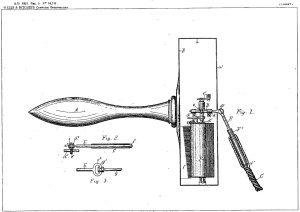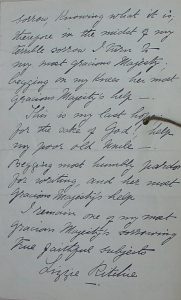
Part of the patent application for the Musical Skipping Rope jointly invented by Charles Deville Wells and Lizzie Ritchie.
In the mid-1880s, Charles Deville Wells began to dream up a series of inventions including an improved ship’s anchor; a new type of parasol; and even a ‘Combination Fire Extinguishing Grenade with Lamp and Chandelier’. Few, if any, of these brainwaves met with financial success, but a glimmer of hope came along in late 1887 when he patented a musical skipping rope and sold it for £5,000 in today’s money.
The British patent – number 16,711 – was jointly in his name and that of a Lizzie Ritchie, whose true identity has never been established. (A United States patent was also granted: US403556A. This can be viewed online at Google Patents). On some occasions Wells described Lizzie as his niece or as his business partner; at other times he claimed to be her guardian. In any event, her name crops up several times in his story.
A few years later he was quizzed by officials about his exploits at Monte Carlo, where he had reportedly won the equivalent of £6 million. Wells said at first that ‘an American gentleman’ had put up the capital for his gambling, but he later changed his story and said that Lizzie Ritchie had been his backer. Under his agreement with her, he had paid her a significant proportion of his winnings. She could not come forward to back up this claim because, he said, she had married a Polish gentleman and was, to the best of his knowledge, living somewhere in Poland.
But when Wells later found himself inconveniently detained in prison, it was Lizzie Ritchie who wrote a grovelling letter to Her Majesty Queen Victoria in the hope of gaining Wells’ release. Was this really from his “niece”? Or had Wells arranged for it to be written and then posted abroad? The address at the head of the letter is in Vienna, Austria, and appears to be a genuine one.
At the National Archives – where the document is kept today – I inspected it closely. The envelope is missing, so I could not check the stamp or postmark. The paper has no visible watermark, or other clue to its manufacture, but when I measured the page I found that it was of a size commonly used at the time in Britain, but not in Continental Europe.

Part of a letter addressed to Queen Victoria and signed “Lizzie Ritchie”. (The National Archives).
According to Wells’ family tree he had no nieces, as only one of his siblings had children, and they were all males. I attempted to locate a match for Lizzie Ritchie in the usual records, including census and birth-marriage-death data, and other sources. There were quite a few individuals of that name and – with no further details to go on – it was impossible to say whether any one of them was the person I was looking for.
But one intriguing clue did emerge. As we have seen, Lizzie Ritchie had been named as Wells’ co-applicant in the patent for the musical skipping rope. Eleven years later, in 1898, a Lizzie Ritchie of Patchogue, New York, took out a patent for a washboard (Patent No. US603410A, which can be seen at Google Patents.) At the time of the skipping rope patent, Lizzie had been described as a British subject, whereas now she is stated to be a US citizen. However, this discrepancy could be explained by her having given incorrect information on her nationality – or she could have become an American citizen in the interval between the two patents.
So was Lizzie Ritchie a real person? Or was she just a creation of Wells’ vivid imagination, whose presence he could magically invoke – like the genie of the lamp – whenever the need arose? As with most of Wells’ associates, it is unlikely that the truth will ever be known.
[Detail from patent application added 21 January 2017]
